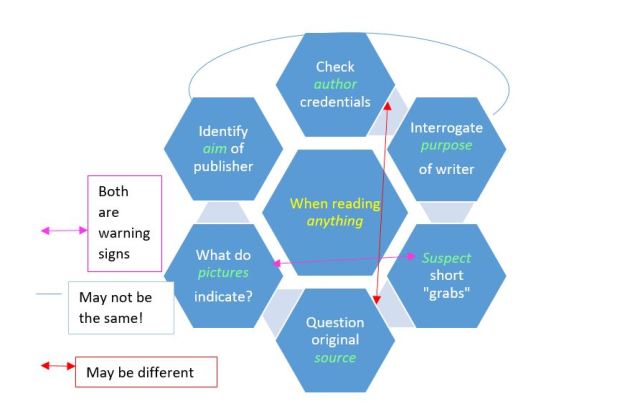We are living in an era where information is readily available, easily created, generally unedited or moderated, and widely shared. It is vital that readers have the capacity to appraise the calibre of content they encounter. Yet, it would appear that even students entering renowned universities cannot apply even the most basic of filters to images or documents presented to them (Weinberg, 2016).
Some simple starting points:

Without applying a filter, or lens to what we read we run the risk of spreading misinformation, thereby perpetuating deliberately created and often specifically targeted fabrications which may be destabilising to governments or undermining to individuals. Far from choosing to be part of such a process, many are inadvertently passed on because people aren’t taking the time to evaluate sources (Tiffany, 2016).
Teacher-librarians such as Valenza promote their role as critical in educating more news literate and savvy information consumers. Tiffany states that this is more effective the earlier that students encounter such educators (Tiffany, 2016).
Coupled with the relatively recent rise in the spreading of “untruthiness”, is the concept held by many that free press equates to neutral information (Valenza, 2016). History teachers are adept at demonstrating that the underlying perspective of the creator, or interpretation of the historian affects the way in which the information s viewed. Much harder to teach, however, is the effect our own attitudes and biases affect the way in which we read and often lead us to ignore viewpoints that differ from our own (Valenza, 2016).
Teaching younger students about appraising calibre and authenticating content is made a little easier by using a resource such as the TED talk on “How to choose your own news” (Brown, 2014) – an engaging animation.
There is no doubt that there has been an exponential increase in the publication of extreme, untrue and misleading “fake news” since the rise of social media such as Twitter and Facebook, partly due to the fact that the number of clicks may equate to real income for the posters (Garun, 2016). This poses a real issue for the founders of such sites, such as Facebook’s Mark Zuckerberg, who has expressed concern at the site being forced into becoming arbiters of truth (Liptak, 2016). The sites on which such “untruthiness” is spread have become known for fostering click bait (Zimdars, 2016).
There have also been allegations that social platforms influenced election results in several countries in 2016 (Garun, 2016). This of itself may not be all bad – but it does indicate the serious need for teaching readers how to negotiate the publications of our time by understanding the underlying purpose of the publications to which they are exposed, and to question the authenticity of what they read, in much the same way that commercial transactions advise that the buyer must be aware. It is critical that leading universities such as Stanford do not continue to find that their students are vulnerable to fake news (Weinberg, 2016).
It is crucial that Australian students are able to learn within their own context about the ways this can be an issue locally, as well as seeing information relating to the United States in particular. We need to be developing Australian resources to support teaching the necessary skills.
As a teacher-librarian and History teacher I am up for the challenge – are you? Join the conversation at #truthinessEDU
References
Brown, D. (Writer), & Harris-Norico, A. (Director). (2014). How to Choose Your News [Motion Picture]. TedED. Retrieved December 3, 2016, from http://ed.ted.com/lessons/how-to-choose-your-news-damon-brown
Garun, N. (2016, November 14). How social platforms influenced the 2016 election. Retrieved December 3, 2016, from The Verge: http://www.theverge.com/2016/11/14/13626694/election-2016-trending-social-media-facebook-twitter-influence
Liptak, A. (2016, November 13). Mark Zuckerberg warns about Facebook ‘becoming arbiters of truth’. Retrieved December 3, 2016, from The Verge: http://www.theverge.com/2016/11/13/13613566/mark-zuckerberg-facebook-misinformation-hoax-media
Tiffany, K. (2016, November 16). In the war on fake news, school librarians have a huge role to play. Retrieved December 3, 2016, from The Verge: http://www.theverge.com/2016/11/16/13637294/school-libraries-information-literacy-fake-news-election-2016
Valenza, J. (2016, 26 November). Truth, truthiness, triangulation: A news literacy toolkit for a “post-truth” world. Retrieved December 3, 2016, from School Library Journal: http://blogs.slj.com/neverendingsearch/2016/11/26/truth-truthiness-triangulation-and-the-librarian-way-a-news-literacy-toolkit-for-a-post-truth-world/
Weinberg, S. (2016, November 26). Stanford Study Finds Most Students Vulnerable To Fake News. (K. McEvers, Interviewer) Retrieved from http://www.npr.org/2016/11/22/503052574/stanford-study-finds-most-students-vulnerable-to-fake-news
Zimdars, M. (. (2016, November 15 ?). False, Misleading, Clickbait-y, and/or Satirical “News” Sources. Retrieved December 3, 2016, from http://d279m997dpfwgl.cloudfront.net/wp/2016/11/Resource-False-Misleading-Clickbait-y-and-Satirical-%E2%80%9CNews%E2%80%9D-Sources-1.pdf
